Originally from Matt Baier’s Organizing Works Newsletter, July 2008
TWO SIDES OF A COIN
If you think of storage as a one-way street, disorganization is inevitable. Instead, I find it helpful to think of storage as a coin, where STORAGE is heads and RETRIEVAL is tails.
Storage without retrieval is not a solution. It is solving one problem by creating another. In fact, the new problem is worse because when things are hidden away without any sort of exit strategy, the odds of ever dealing with them plummet. Most likely it won’t occur to us to deal with stashed items until we can stash no more. That’s usually when I get a call.
Here are six typical areas where retrieval is lacking and ways to improve them.
1. Storage Closets. Having lived in many small city apartments, I know that sometimes you have nowhere else to store unused items than a closet. This, however, is not the time to throw up your hands and say you have no storage. It is the time to truly prioritize and use your limited space most carefully. For example, with well-filled, lidded banker boxes, you can stack six boxes in just one square foot of floor space. So how does this help retrieval? By storing lesser-used items in the back of your closet, you free up more space in the front of your closet for tools, supplies and other items you need to retrieve regularly. Not all spots in a closet are created equal. Top shelves are best for seasonal and other items you don’t use every day. Finally, if you must fill up that last square foot of space, place a single large item with wheels there, so you can easily access the back of the closet or so you can place a step stool there to access the top shelf.
2. Inbox. An inbox provides a clearly dedicated space for delivering your incoming mail and documents, and for distinguishing them from other ongoing projects that may be piling up on your desk. This much is good. The problem comes when this system for processing is treated as a permanent system for storage without an effective system for retrieval. The less you have to deal with, the more likely you are to deal with it. Effective retrieval, therefore, demands that you divide and conquer. By simply putting your reading material in one area, your bills in a bill paying area, and obvious junk mail in the trash, you can cut your mail by 75-100%. That remaining 0-25% then becomes dramatically more manageable.
3. Office Overload. Every piece of paper you keep ultimately demands just two imperatives:
a. Act on it
b. Find it.
Keeping paper in piles is counterproductive to both. Large amounts of paper that demand action will be the subject of next month’s newsletter, but paper that demands retrieval I will address here. If it’s important to find, it’s important to file. Let me be clear on this. I’m not talking about the pages that demand reading or some other action. I’m talking about the pages that you are done with for now, but may need to lay your hands on again. If your work has required that you keep large amounts of paper accessible in the past, it will require the same in the future. Since it’s not going away, make the appropriate allowances. Yup, you gotta get another file cabinet. Make it a low two drawer one that will give you the additional surface area, vital for processing those huge quantities. Finally, use box bottom hanging files and take a minute to label them clearly. They hold more files visibly and they can increase your file space by up to 40%. Visibility creates findability and findability means you can trust your file cabinets for retrieval.
4. Car. In my line of work, I come across many make-it-go-away bags, but none more familiar than those that come from a car. It’s an assortment of stuff that no one wants to deal with. Again, my recommendation is to take just two minutes to divide it up into the most basic of categories: all clothes into the laundry room, kid’s stuff into the kids’ room(s), loose papers into the home office. Miscellaneous stuff will at least end up in a MUCH smaller bag. I understand how busy you are because I am too. And as a busy person, I know that that rainy day for emptying make-it-go-away bags isn’t coming. So divide now, conquer later. This significantly increases your odds for retrieval.
5. Pockets/ Pocketbooks. Ideas need a plan for retrieval too. It’s comforting to get an idea out of your head by writing it down on a scrap of paper, but odds are good that that idea will go nowhere without a plan for retrieval. This is especially true if you have combined personal information, work information, contact information, on two different sides of the same piece of paper. The information from this paper can’t be easily broken up and moved forward. Keep this information separate as you are writing it and it will enable you to divide and conquer when you take it out of your pocket or pocketbook, increasing the odds of converting an idea into action.
6. To Do List. So how exactly do you take the next step with your separated ideas and act upon them? You may find it a bit like organizing wild horses. My answer to those wild horses is what I call Project Corrals. I recommend collecting each set of large project ideas in a clear plastic envelope (yes dear clients THOSE ones). How do you eat an elephant? One bite at a time. Write each action (each bite) on a small Post-It note and collect it on one page (you can fit 28 Post-Its). Keep each page of ideas in a separate project envelope. This system asks only that you block out just 15 minutes a week (the day before Monday makes sense to me) to review your big projects and prioritize which of those actions (those bites) you can fit into next week. In David Allen’s book Getting Things Done: The Art of Stress Free Productivity, his central answer is to get all the thoughts that are floating around your head out AND into a system you TRUST. Project Corrals are just such a system, because they contain an easy plan for retrieval.
Remember, if you only have a plan for storage, then you are only looking at the head side of the coin. A plan for retrieval is the tail side of the coin and if you get tails you win!

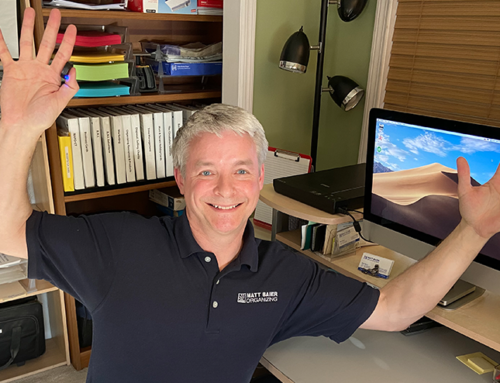
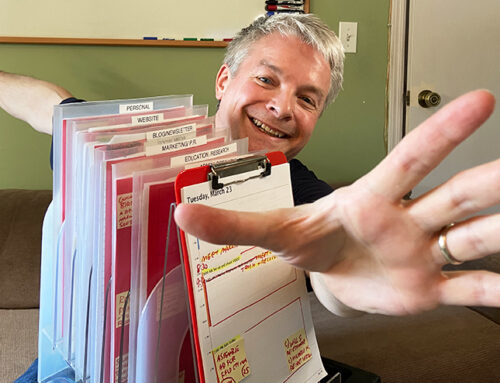
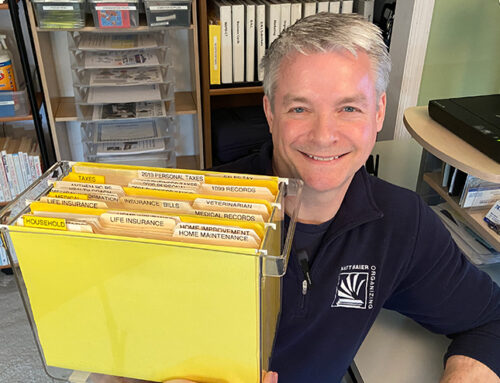
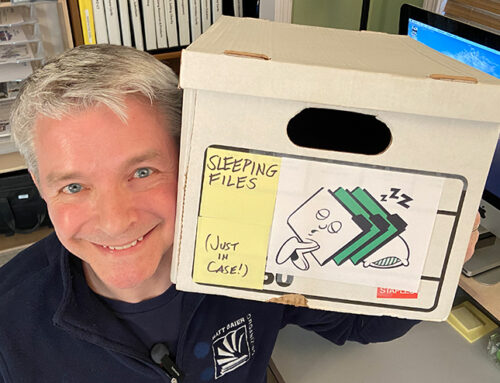
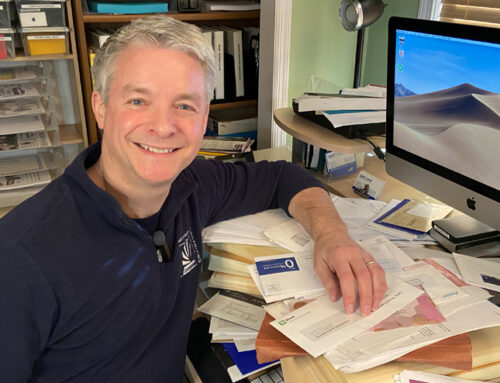






[…] ideas are not captured in a safe place, they will be lost. For this I recommend an idea I call project corrals. The idea is that given the reality that your ideas are going to far exceed your ability to act on […]
[…] folder with pockets for daily receipts. Long term to-do’s go on small Post-its, which I keep in project corrals (#6). I update all appointments as they come up in my iPhone, which is always on […]